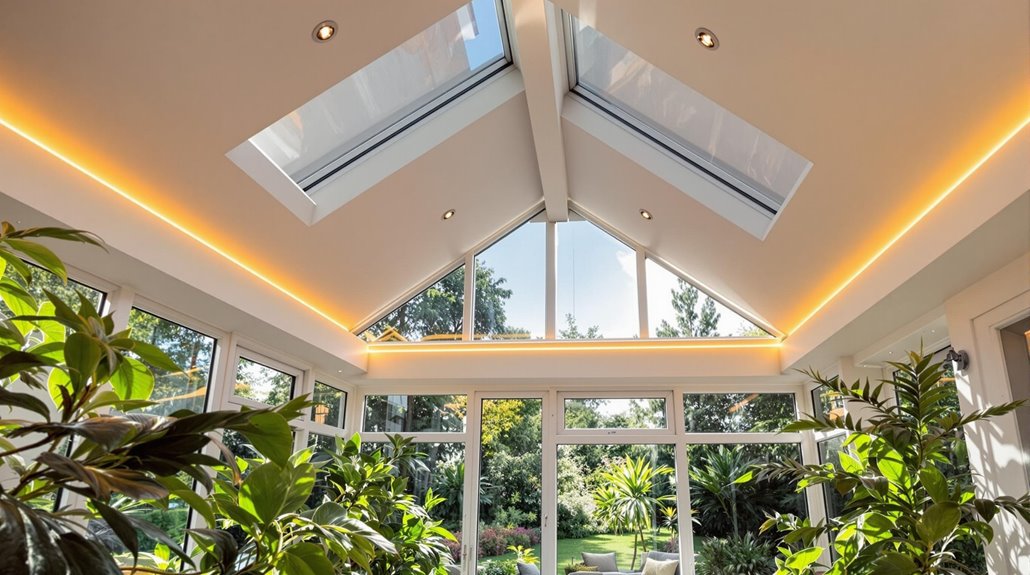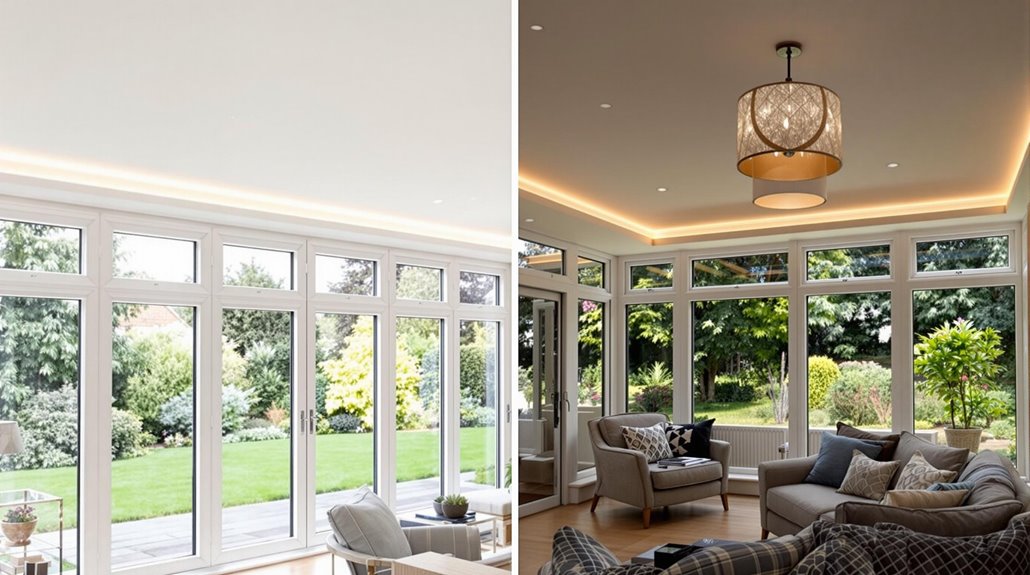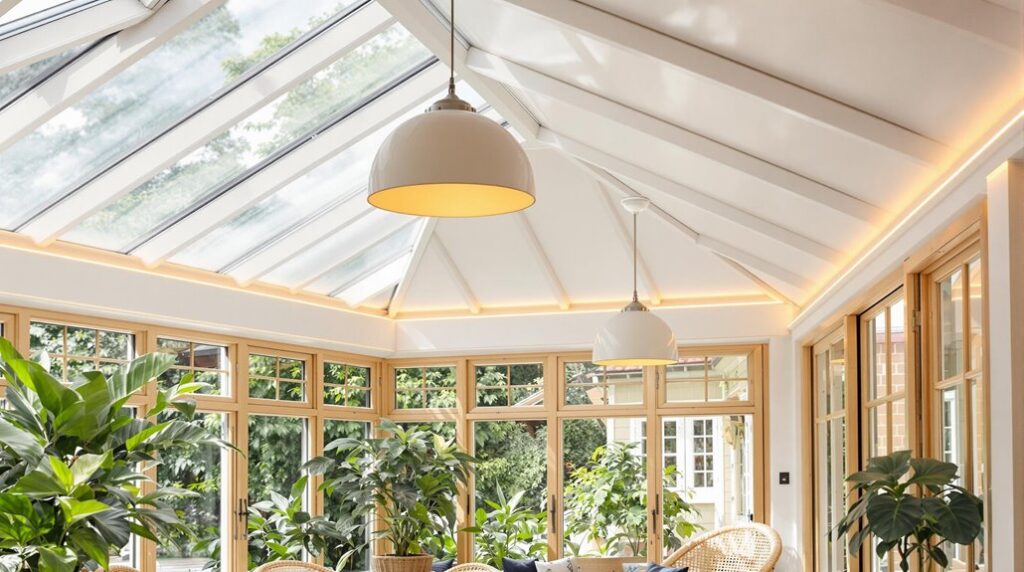I’ve helped countless homeowners transform their dim conservatories into bright, functional spaces through strategic lighting choices. The key isn’t simply adding more fixtures—it’s understanding how to layer different lighting types to solve specific problems your extension faces. Whether you’re dealing with dark corners during winter months or need better task lighting for your morning coffee routine, the right combination of pendant lights, downlights, and accent lighting can completely change how you use this valuable space.
Key Takeaways
- Install pendant lights on chains to accommodate sloped conservatory ceilings while creating attractive focal points throughout the space.
- Layer ambient, task, and accent lighting with dimmable controls to adapt from bright working conditions to relaxing evening atmosphere.
- Use warm white LEDs under 3,300K with wall-mounted sconces to create soft, indirect illumination perfect for relaxation areas.
- Combine ceiling downlights for reading zones with LED strip lighting around edges to highlight architectural features and plants effectively.
- Hire professional electricians for safe installation and integrate outlets discreetly into foundation walls for clean, functional aesthetics.
Essential Lighting Types for Your Conservatory Space

When designing your conservatory’s lighting scheme, you’ll need to understand the five essential lighting types that work best in these unique glass-walled spaces.
Pendant lighting gives you chain-mount flexibility for sloped ceilings while creating stunning focal points. I recommend crystal or sculptural designs that won’t obstruct your sightlines.
Wall lighting solves ceiling constraint issues by providing gentle, indirect illumination that extends to your patio areas. You’ll find styles matching your conservatory’s architecture.
Ceiling downlights deliver focused task lighting with adjustable directional heads for reading zones. Their recessed design preserves clean aesthetics.
Fan-integrated lighting combines cooling with illumination, perfect for summer comfort without separate systems.
LED strip lighting offers maximum versatility with flexible installation along beams or shelves, plus color-tunable options adapting to day-night shifts. These LED technology solutions provide exceptional energy efficiency for year-round use.
Creating Functional Illumination for Daily Activities
Since your conservatory serves multiple purposes throughout the day, you’ll need a strategic lighting approach that adapts to each activity’s specific requirements. I recommend mapping your space into functional zones—reading corners need focused task lighting, while dining areas benefit from warm ambient illumination. Incorporating stunning designs can elevate the overall aesthetic of your conservatory.
You’ll want to implement layered lighting that combines general, task, and accent elements. Install dimmer switches so you can adjust intensity based on whether you’re working, relaxing, or entertaining. Motion sensors in low-traffic areas will save energy without compromising convenience.
Consider your plants’ needs too—they require rest periods, so use timers to avoid disrupting their natural cycles. LED fixtures offer the best energy efficiency and won’t generate excessive heat that could stress your greenery while providing the precise control you need. The roof shape of your conservatory will also influence whether you can install central ceiling lights or need to rely on alternative mounting solutions.
Design Strategies for Beautiful Conservatory Ambiance

While functional lighting handles your conservatory’s practical needs, creating beautiful ambiance requires a more artistic approach that transforms your glass sanctuary into a stunning focal point. I’ll show you how layering different light sources creates depth and warmth that makes your space truly inviting.
Start with pendant lights as your foundation—they’ll provide both illumination and visual interest. Add wall-mounted sconces with frosted glass to minimize reflections while casting soft, indirect light. Crystal fixtures work brilliantly here, refracting light beautifully against your glass surfaces. Incorporating eco-friendly materials can enhance both the aesthetic and sustainability of your lighting choices.
Control temperature with warm white LEDs under 3,300K for evening relaxation. Install dimmable systems so you can shift seamlessly from bright task lighting to intimate ambiance. For larger conservatories with expansive roof lanterns, consider adding additional lighting such as strategically placed spotlights to prevent dark spots from forming in these impressive overhead features. Cove lighting eliminates harsh contrasts, while accent uplighting highlights your plants and architectural features, creating that magical atmosphere we’re all seeking.
Technical Considerations for Professional Installation
Before you hang your first fixture, proper electrical infrastructure planning will make or break your conservatory lighting project. I recommend hiring a professional electrician if you don’t have pre-existing electrical networks—trust me, it’s worth the investment for safety and functionality.
Foundation walls are your secret weapon for discreet outlet integration. They’ll hide wiring while providing practical power supply solutions that maintain your glass structure’s clean aesthetic. Your conservatory’s type and roof shape directly impact wiring feasibility, so plan accordingly. Additionally, consider how glass roof extensions can complement your lighting choices by enhancing natural light flow.
If you’re renting or retrofitting, I’d suggest battery-powered or USB-rechargeable fixtures for maximum flexibility. Solar-powered LEDs work brilliantly in conservatories since you’ve got abundant natural light to charge them. LED strips can be strategically placed under shelves or around skirting boards to create beautiful ambient lighting effects. Wall-mounted fixtures definitely require professional installation expertise—don’t attempt this yourself.
Achieving Versatile Atmosphere With Layered Lighting

Creating the perfect conservatory atmosphere requires mastering the art of layered lighting—a strategic approach that transforms your glass sanctuary from stark and clinical to warm and inviting. I’ll show you how three distinct lighting layers work together seamlessly.
Start with ambient lighting as your foundation—this provides overall illumination throughout your space. Next, add task lighting for specific activities like reading or dining. Finally, incorporate accent lighting to highlight architectural features and create visual depth. Layering different light sources can significantly enhance the overall effect and functionality of your conservatory.
Strategic placement matters enormously in glass rooms. I recommend strip lights around outer edges to frame your conservatory’s structure, while uplighters at wall bases reflect warm glows upward. For flexibility, combine central pendants for bright gatherings with softer floor lamps for evening relaxation, adapting your space to different moods effortlessly. Remember that brighter task lighting is essential for any precision work like cooking or crafting, as it eliminates overhanging shadows that could compromise safety and efficiency.
Integrating Indoor and Outdoor Lighting Elements
Since conservatories blur the boundary between indoor and outdoor spaces, I’ll help you create seamless lighting shifts that eliminate the jarring disconnect many homeowners experience at night. I recommend installing matching wall lights on both your conservatory’s interior walls and adjacent exterior house walls—this creates visual continuity that makes your space feel intentionally designed.
You’ll want to maintain warm white lighting (under 3300K) throughout to complement outdoor ambient sources. Position lower-level table lamps to reduce harsh reflection contrasts, and choose matte-finish fixtures to minimize glare through glass panels.
For your garden perimeter, space LED path lights 6-8 feet apart using IP65-rated fixtures. This frames your outdoor views beautifully while ensuring your conservatory feels naturally integrated with your landscape. Consider adding motion detectors to your outdoor lighting circuit to optimize energy usage and provide automatic illumination when moving between spaces.
Conclusion
I’ve covered the essential lighting strategies to transform your conservatory from a dim afterthought into a functional, beautiful space. You’ll need layered lighting—combining pendants, downlights, and LED strips—with proper dimming controls for versatility. Don’t forget technical considerations like waterproofing and electrical safety. Start with your primary task lighting, then add ambient layers. With these tools and techniques, you’ll create a conservatory that works perfectly for both daily activities and evening entertaining.
References
- https://www.homebuilding.co.uk/ideas/conservatory-lighting-ideas
- https://www.thelightingsuperstore.co.uk/interior-lighting/conservatory-lighting
- https://www.conservatoryland.com/blog/conservatory-lighting/
- https://www.pinterest.com/pin/464504149072518295/
- https://www.johncullenlighting.com/lighting-tips/conservatory-lighting-ideas/
- https://www.valegardenhouses.co.uk/articles/guide-to-conservatory-lighting/
- https://cosypanels.co.uk/7-conservatory-lighting-ideas/
- https://www.thelightingpractice.com/lighting-for-life-a-research-driven-approach-for-odus-orchid-conservatory/
- https://www.ultraframe-conservatories.co.uk/news/how-to-choose-conservatory-lighting
- https://www.numberanalytics.com/blog/active-lighting-modern-architecture-trends

